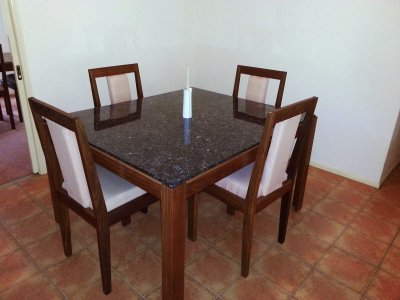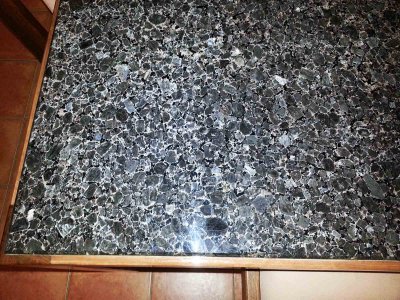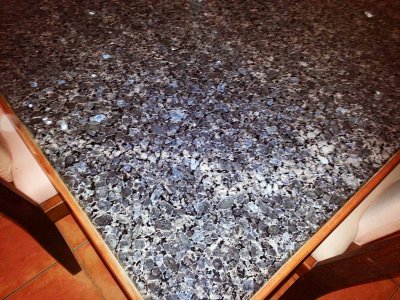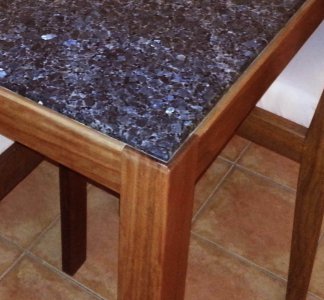Hi, I had this granite slab for quite a while whilst waiting for my Ironbark timber to dry, had to cut it to size, square it and do the chamfer on the edge, polished it up and
then sealed it to protect the surface from food spills etc.
The legs are "L" shaped and joined to the sides with Titanbond 3 wood glue, made a 10mm recess around the sides and the top of the legs for the slab to sit inside. There are also 2
pieces of timber under the slab to support it. Where they join on to the sides there is a glued block on either side of them to glue the crosspieces to the table sides.
In addition there are two pieces of dovetailed timber which are glued at 90 degrees in the inside corner of the legs and overlap the the side timbers to tie the legs to the
sides, as well as 10 stainless screws just in case the glue cracks, with that much weight I don't want a leg to crack off if it gets bumped. It took 2 other guys and myself to
get this table inside the house from under the carport where I built it.
I glued the whole lot with Titanbond 3 but it didn't stick to the granite, so when I took the sash clamps off, the entire timber frame separated from the granite. I then had to clean up the glue and then used
Sikaflex-11FC which worked well. Had to wait for two days for the Sikaflex to cure before I took the clamps off.
The 4 Jarrah chairs were made 19 years ago for a Jarrah dining table I made, I made 10 chairs but it was too crowded with that many and so I ended up with these 4 as spares. Over
that period of time the Jarrah has darkened and now is almost a perfect colour match for the Ironbark timber. The granite table colour changes with the direction of light and
ranges from steely metallic grays with pink and cream highlights to grey, white and black.
The Ironbark timber is coated in Cabots interior/exterior clear gloss polyurathane which will give it good protection from food and moisture or liquid spills.
Cheers
Ed.




then sealed it to protect the surface from food spills etc.
The legs are "L" shaped and joined to the sides with Titanbond 3 wood glue, made a 10mm recess around the sides and the top of the legs for the slab to sit inside. There are also 2
pieces of timber under the slab to support it. Where they join on to the sides there is a glued block on either side of them to glue the crosspieces to the table sides.
In addition there are two pieces of dovetailed timber which are glued at 90 degrees in the inside corner of the legs and overlap the the side timbers to tie the legs to the
sides, as well as 10 stainless screws just in case the glue cracks, with that much weight I don't want a leg to crack off if it gets bumped. It took 2 other guys and myself to
get this table inside the house from under the carport where I built it.
I glued the whole lot with Titanbond 3 but it didn't stick to the granite, so when I took the sash clamps off, the entire timber frame separated from the granite. I then had to clean up the glue and then used
Sikaflex-11FC which worked well. Had to wait for two days for the Sikaflex to cure before I took the clamps off.
The 4 Jarrah chairs were made 19 years ago for a Jarrah dining table I made, I made 10 chairs but it was too crowded with that many and so I ended up with these 4 as spares. Over
that period of time the Jarrah has darkened and now is almost a perfect colour match for the Ironbark timber. The granite table colour changes with the direction of light and
ranges from steely metallic grays with pink and cream highlights to grey, white and black.
The Ironbark timber is coated in Cabots interior/exterior clear gloss polyurathane which will give it good protection from food and moisture or liquid spills.
Cheers
Ed.





